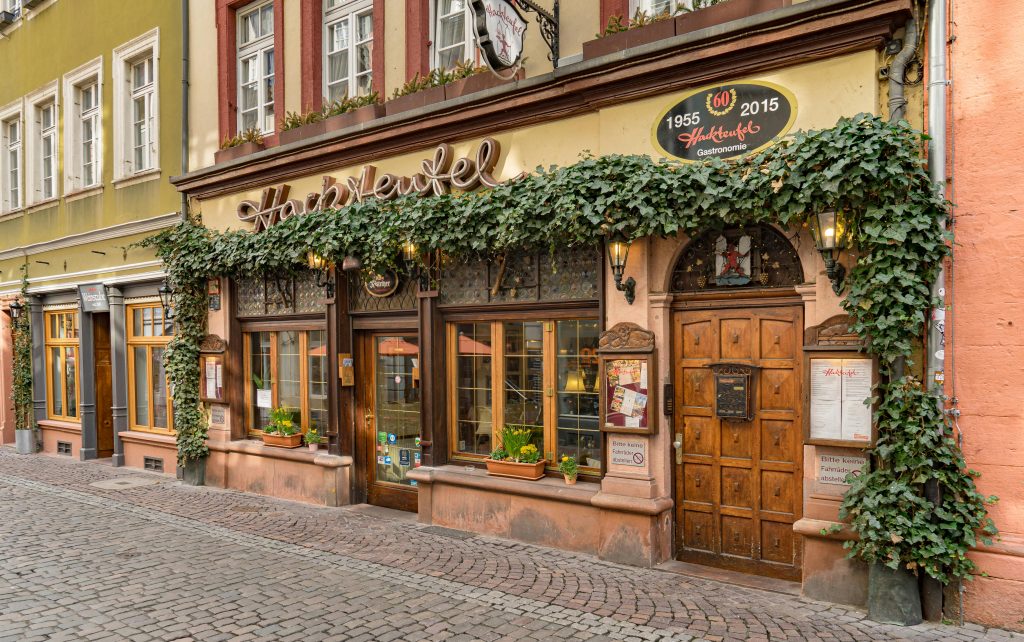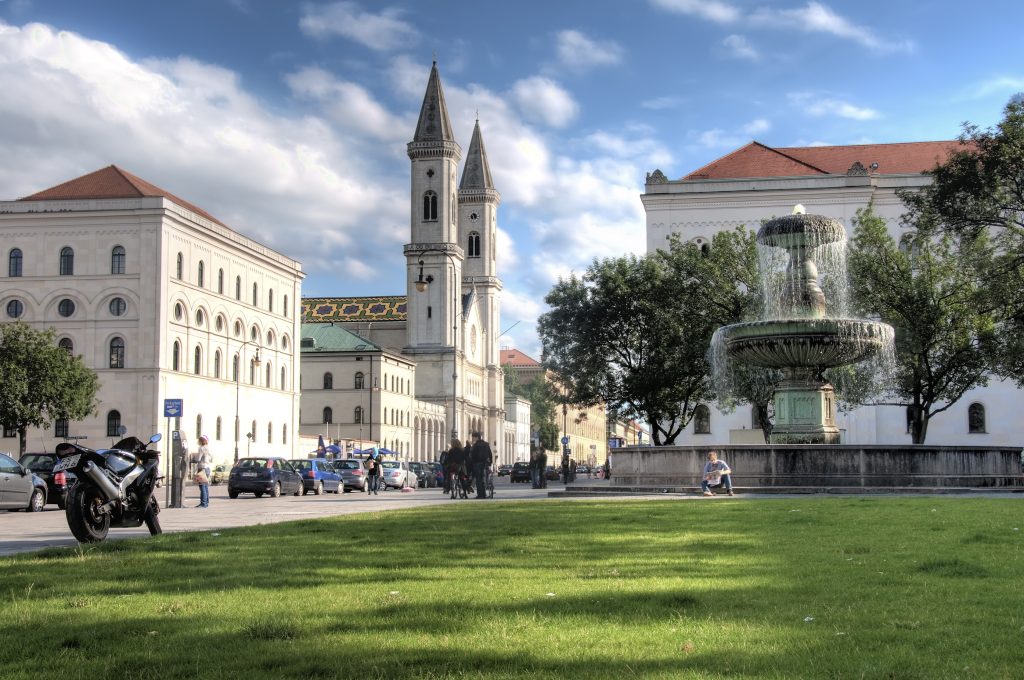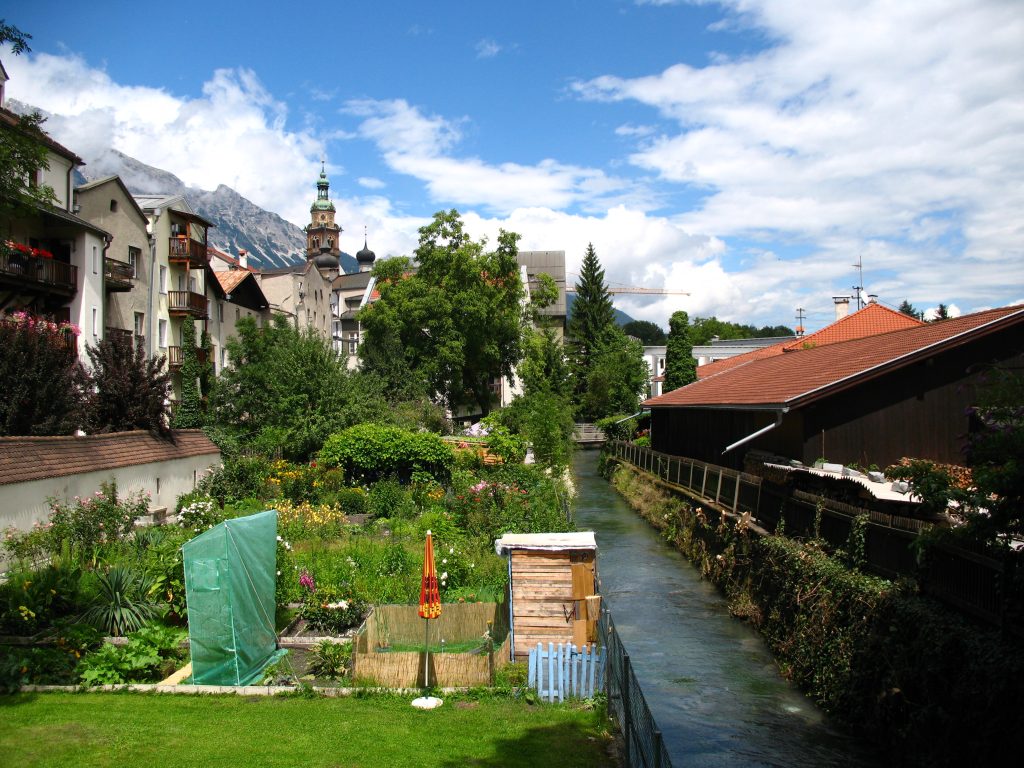1.3 Meine Wohnungslage

Lektionsüberblick
Now that you can talk more specifically about your home’s interior, let’s look at how to talk about your home’s surroundings, including building and landmarks. By the end of this lesson, you will be able to 1) talk about a typical city, 2) talk about the location of your apartment and the university, and 3) explain how to get to the university from your apartment.
1) Die typische Stadt
There is much to see and do in the downtown area of a city (die Innenstadt). Many German towns also have an old town (die Altstadt). Here are some other places you might see. The first list is full of cognates (words that are similar in both English and German).
Now for words that might require a little more practice…
Kleiner Hinweis
Jetzt bist du dran!
Think about the buildings and landmarks that you pass to and from home. Look above at the activities, and write down any important buildings or landmarks in your written journal. Be sure to include the article (der, die, das).
Now record yourself in your audio journal saying these important words aloud. Be sure to listen to your recording and rerecord, if you are not satisfied.
2) Meine Wohnungslage
Do you live across the street from a supermarket? Do you live nearby a university? You’ll need to know some new words to express these types of relationships. Look at the sentences and pictures below. Then practice. Be sure to click through to each question.
 Barbara sagt: Barbara sagt:
“Ich wohne einem Restaurant gegenüber.” |
|
|
 Anja und Dirk sagen: Anja und Dirk sagen:
“Wir wohnen in der Nähe von der Uni.” |
|
|
 Karl sagt: Karl sagt:
“Ich wohne neben dem Bach.” |
|
|
|
3) Wegbeschreibungen
Some people are good with giving and following directions to new places. Others might find this challenging in any language. But knowing the words and phrases is always the first step. Read and listen to these flashcards, then practice using your new words and phrases.
In addition to telling someone how to go from A to B, you may also want to say how you go from A to B. In the following text, you will read (and hear) how Sebi describes their way to the university. They will answer the questions: Sebi, wo wohnst du und wie kommst du zur Uni?
Sebi sagt: Ich wohne in einem kleinen Zimmer in einem Studierendenwohnheim. Die Universität ist in der Nähe davon. Ich komme aus meinem Wohnheim und biege nach rechts ab. Ich gehe die Straße entlang zum Park. Ich gehe durch den Park und dann über die Brücke. Ich biege nach links ab und die Universität ist direkt vor mir.
Let’s practice. Be sure to click through to each question.
Jetzt bist du dran!
Wie kommst du zur Uni? How do you get to the university from your place of residence? If you are an online student, how do you get to your favorite place or study spot from your home?* Using Sebi’s description as a template, write out directions to the university from your place.
*zu meinem Lieblingsplatz zum Lernen = to my favorite place to study
Jetzt kombinieren!
In the previous lesson, you learned to describe the features of your house and the rooms in your house. In this lesson, you learned to 1) talk about a typical city, 2) talk about the location of your apartment and the university, and 3) explain how to get to the university from your apartment.
Wo wohnst du? Welche Orte sind in der Nähe? Wie kommst du zur Uni?* In your written journal, let’s combine the information from both lessons, like this:
- Ich wohne in einem Einfamilienhaus in der Nähe von der Uni.
- Ich wohne einem Supermarkt gegenüber und es gibt eine Drogerie und eine Post in der Nähe.
- Die Universität* ist in der Nähe von meinem Haus. Ich komme aus meinem Wohnheim und biege nach rechts ab, u.s.w. (und so weiter)…
- If you want to challenge yourself, instead of saying how you get to the university, give someone directions like the ones you saw on the flashcards. Decide whether you will give directions in the context of a formal conversation (Gehen Sie…!) or informal one (Geh…!). Or, you can go through your directions twice in order to practice both formal and informal commands.
Then record yourself in your audio journal. Be sure to listen to your recording and rerecord, if you are not satisfied.
*or zu meinem Lieblingsplatz zum Lernen = to my favorite place to study
Media Attributions
- Directions flashcards adapted from Willkommen: Deutsch für alle, Copyright © 2020 by Claudia Kost and Crystal Sawatzky, licensed under the CC BY-NC-SA International License 4.0.
Media Attributions
- 2030-2040 ch banner reduced size
- Photo of restaurant by pexels-reto-wiezel-3245195-18510563 © Reto Wiezel
- Photo of university by Werner Kunz, Attribution-NonCommercial-ShareAlike 2.0 Generic © Werner Kunz is licensed under a CC BY-NC-SA (Attribution NonCommercial ShareAlike) license
- Bach © Andrew Bossi is licensed under a CC BY-SA (Attribution ShareAlike) license

